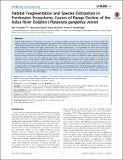Habitat fragmentation and species extirpation in freshwater ecosystems; causes of range decline of the indus river dolphin (Platanista gangetica minor)
Abstract
Habitat fragmentation of freshwater ecosystems is increasing rapidly, however the understanding of extinction debt and species decline in riverine habitat fragments lags behind that in other ecosystems. The mighty rivers that drain the Himalaya - the Ganges, Brahmaputra, Indus, Mekong and Yangtze - are amongst the world's most biodiverse freshwater ecosystems. Many hundreds of dams have been constructed, are under construction, or are planned on these rivers and large hydrological changes and losses of biodiversity have occurred and are expected to continue. This study examines the causes of range decline of the Indus dolphin, which inhabits one of the world's most modified rivers, to demonstrate how we may expect other vertebrate populations to respond as planned dams and water developments come into operation. The historical range of the Indus dolphin has been fragmented into 17 river sections by diversion dams; dolphin sighting and interview surveys show that river dolphins have been extirpated from ten river sections, they persist in 6, and are of unknown status in one section. Seven potential factors influencing the temporal and spatial pattern of decline were considered in three regression model sets. Low dry-season river discharge, due to water abstraction at irrigation barrages, was the principal factor that explained the dolphin's range decline, influencing 1) the spatial pattern of persistence, 2) the temporal pattern of subpopulation extirpation, and 3) the speed of extirpation after habitat fragmentation. Dolphins were more likely to persist in the core of the former range because water diversions are concentrated near the range periphery. Habitat fragmentation and degradation of the habitat were inextricably intertwined and in combination caused the catastrophic decline of the Indus dolphin.
Citation
Braulik , G T , Arshad , M , Noureen , U & Northridge , S P 2014 , ' Habitat fragmentation and species extirpation in freshwater ecosystems; causes of range decline of the indus river dolphin ( Platanista gangetica minor ) ' , PLoS One , vol. 9 , no. 7 , e101657 . https://doi.org/10.1371/journal.pone.0101657
Publication
PLoS One
Status
Peer reviewed
ISSN
1932-6203Type
Journal article
Description
World Wildlife Fund-Pakistan -(http://www.wwfpak.org/) funded the interview surveys with support through the Pakistan Wetlands Project. The US Marine Mammal Commission (www.mmc.gov) provided funding to GB for reporting and analysis in grant number E4047595.Collections
Items in the St Andrews Research Repository are protected by copyright, with all rights reserved, unless otherwise indicated.

